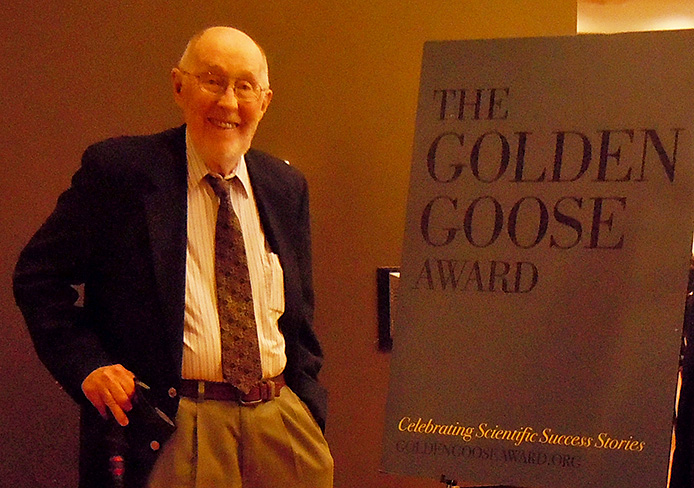
It may not have seemed significant in 1967 when OSU alumnus Thomas Brock discovered a microorganism at Yellowstone National Park, but he was given credit for his work with the Golden Goose Award in Washington, D.C., last week.
The award, represented with a trophy, recognizes federally funded research that may have seemed insignificant at the time of discovery but has since shown societal impact, according to a Golden Goose press release.
What makes the bacterium, named Thermus aquaticus, unique is its ability to live in temperatures almost as high as the boiling point of water. Brock said that quality was what later made his discovery significant.
“When they were developing techniques for studying DNA, they needed an enzyme that would work at high temperatures,” Brock, who graduated from OSU in 1952 with bachelor’s, master’s and Ph.D. degrees in botany, said.
The bacteria that were being used could not tolerate the heat and were inactivated, he said. Due to its heat-resistant trait, though, an enzyme of Thermus aquaticus became a crucial factor in DNA processing.
The bacterium has recently been used as part of a process called polymerase chain reaction, which allows researchers to produce copies of specific DNA sequences for DNA testing, sequencing and diagnosing disease. Brock said the process is key to studying DNA.
“Almost anything where you’re going to do DNA work uses this technique. Although I didn’t discover the technique, the organism I discovered plays a critical role in it,” Brock said.
At the time of the discovery, Brock was a professor of microbiology at Indiana University. He and a then-third-year undergraduate research assistant, Hudson Freeze — who won the Golden Goose Award along with Brock — isolated a strand of the organism which was used by Kary Mullis to perfect the technique of PCR, Freeze said.
Mullis’ technique won him a Nobel Prize and “went on to be the basis of essentially the entire genetic revolution,” Freeze said.
“Today, every rare disease that’s being diagnosed is diagnosed on the basis of changes in the DNA, and you evaluate and recognize those changes because of PCR,” Freeze said.
Brian Lower, an OSU assistant professor of environmental microbiology, said PCR has made many other discoveries possible.
“It opened the door to all sorts of different tools for biotechnology, agriculture and forensic science,” Lower said.
Other uses include DNA isolation, amplification and quantification, Freeze said, which can use trace amounts of ancient DNA to help identify what types of diseases Egyptian King Tutankhamun, who lived during 1300 B.C., may have had or help identify the body of English King Richard III, who lived in the 1400s.
“The possibilities are endless because every organism except for a few viruses has to have DNA, so you can recognize the fingerprints of that DNA by using PCR,” Freeze said.
Much like the surprise of Thermus aquaticus’s eventual application, the Golden Goose Award came out of the blue, Freeze said.
“The importance of the story is really to show you can’t predict where science is going to take you, and one discovery that seems unimportant or even wrong-headed can turn out to be something really important,” Freeze said.
Both Brock and Freeze attended the award ceremony Thursday, where they used their spotlight to highlight the importance of federally-funded research to the members of Congress in attendance, Brock said.


